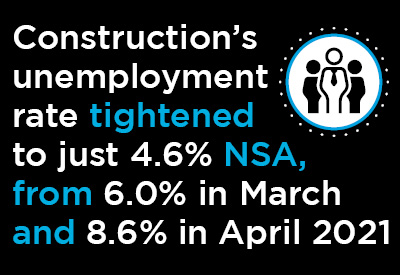Turmoil in the stock markets, an inflation rate that won’t quit and interest rates that have only just begun their journey higher failed to deter robust U.S. jobs growth in April. The Bureau of Labor Statistics (BLS), in its , asserts that total U.S. employment climbed upwards by 428,000 positions in the latest month.

Also, while the seasonally adjusted (SA) unemployment rate stayed the same in April as in March, at 3.6%, the not seasonally adjusted (NSA) U rate fell to a barely perceptible 3.3% from 3.8% the month prior.
The count of unemployed individuals in America is now 5.5 million NSA or 5.9 million SA. March’s Job Openings and Labor Turnover report (aka, the story) says there are currently 11.5 million open spots in the country. Further compression of the U rate seems likely and present labor market circumstances are providing workers with more wage and working- condition leverage.
The four-month average monthly jobs gain in 2022 has been over half a million, at +518,000. Last year’s first-four-month average was a little better, at +549,000.
As per usual, private services firms provided the bulk of the new jobs in April, +340,000, with the ‘leisure and hospitality’ sector on a hiring tear, +78,000 jobs. ‘Food services and drinking places’ alone (i.e., bars and restaurants) added to their staffing by +44,000.
Job Creation to Alleviate Inflation
But there were two other sectors that played unusually prominent roles in jobs creation and it’s interesting to speculate on their motivation. Much of today’s inflation problem is being caused by supply shortages. To help unlock logistical bottlenecks, the ‘transportation and warehousing’ sector has increased its payroll count by +7.8% year over year. In April, it added 52,000 jobs.
The manufacturing sector is also doing its part to alleviate inflation by taking steps to increase the supply of many goods. The number of total U.S. manufacturing jobs in April shot up by +55,000.
The construction sector’s employment performance in April was lame, only +2,000 jobs. ��������ion’s unemployment rate, though, tightened to just 4.6% NSA, from 6.0% in March and 8.6% in April 2021.��
Solid Wage Gains
Solid year-over-year increases in compensation rates were again seen in the latest month. For all jobs, including bosses, the climbs were +5.5% hourly and +4.6% weekly. ��������ion workers, as a subset of all jobs, had little to complain about with a matching increase hourly, +5.5%, and an even better gain weekly, +4.9%.
For all jobs, but excluding, supervisory personnel, April’s y/y wage increases were +6.4% hourly and +5.5% weekly. ��������ion worker didn’t quite keep up, at +5.3% hourly and +4.8% weekly.
Hopes for Soft Landing
The Federal Reserve has just lifted the range for its leading interest rate indicator, the federal funds rate, by 50 basis points (where 100 basis points = 1.00%), to sit at 0.75%-1.00%. The Fed has also signaled that, over coming months, another couple of plus-50-basis-point moves are in the cards.
The hope is that a so-called ‘soft landing’, to rein in inflation while also permitting modest GDP growth, can be achieved (i.e., an economic slowdown that doesn’t deteriorate into an unpleasant recession). Frankly, given how hot the labor market is, the Fed will be hard pressed to successfully pull off its high-wire act.
Lackluster Jobs Creation in Canada in April
The job-creation record north of the border in April was a lackluster +16,000 jobs, according to .
Especially disappointing was the -21,000 month-to-month reduction in Canadian construction jobs. Last year’s super-charged homebuilding market won’t find an equal this year. (The Bank of Canada has raised its key policy-setting ‘overnight’ rate to 1.00%.)
Canada’s ‘headline’ SA unemployment rate has tightened a notch to 5.2% from 5.3% in March. But it’s the NSA U rate, calculated using the same methodology as in the U.S., that has become impressive, only 4.4% (although it still lies above the 3.3% figure south of the border). ��
Where Canada is leading the U.S. on the labor side, though, is in its jobs’ recovery versus the notorious COVID-induced slide between February and April of 2020. Canada has now restored all the jobs that disappeared in the Spring of two years ago. The U.S. has a jobs claw-back ratio of only 95%.
Total U.S. employment remains -1% compared with its peak level of February 2020.
Canada has gone beyond its February 2020 level of employment by +2.4%.
Alex Carrick is Chief Economist for ��������Connect. He has delivered presentations throughout North America on the U.S., Canadian and world construction outlooks. Mr. Carrick has been with the company since 1985. Links to his numerous articles are featured on Twitter��, which has 50,000 followers.










Recent Comments
comments for this post are closed